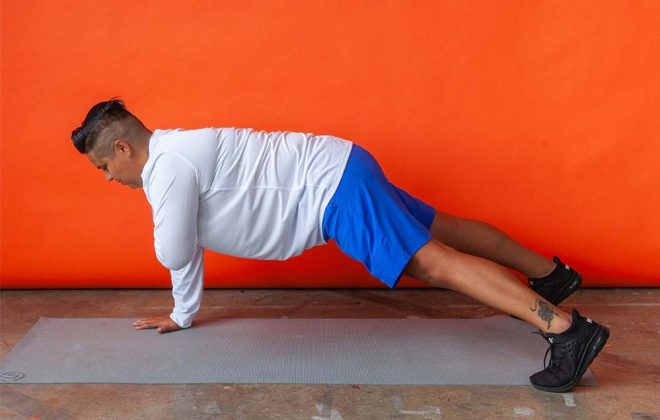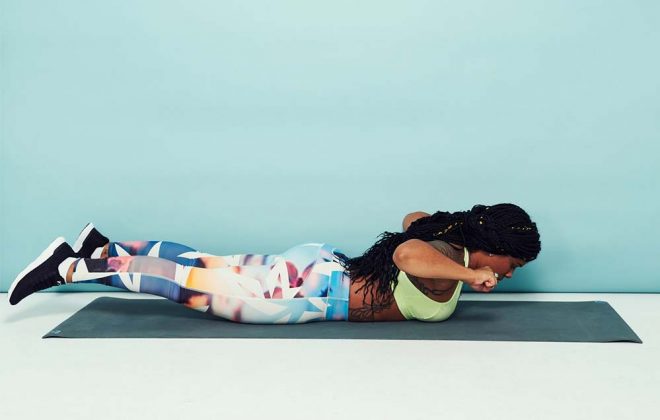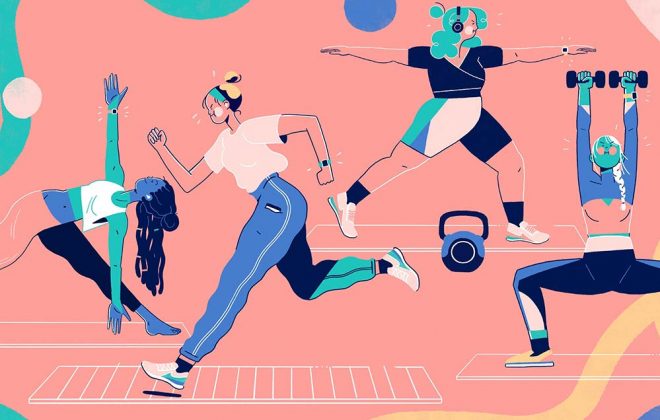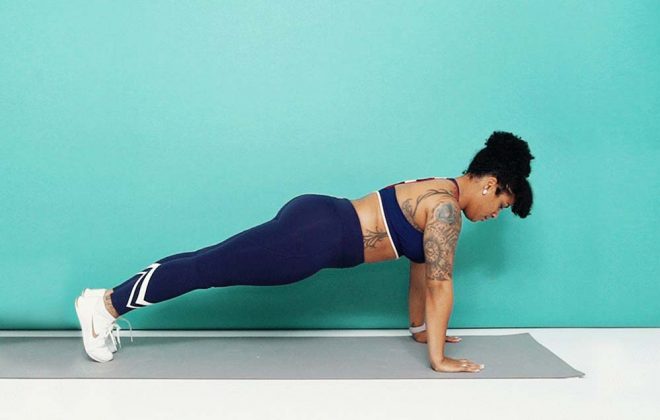Release Station
June 17, 2021
8 Relaxing Exercises That Will Release Tension From Your Entire Body
When I’m really stressed, I feel it in my body. And if you’re anything like me, you’ve also been feeling super tense lately. But there are relaxing exercises we all can do to both reduce total-body tension and calm our worried minds. They might not be a cure-all, but they may make you feel better for the moment.
“We tend to separate out the mind and the body, and they’re so linked,” clinical psychologist Charlynn Ruan, Ph.D., founder of Thrive Psychology Group in Los Angeles and New York, tells SELF. Mental stress can cause your muscles to tighten as your body tries to protect itself against injury and pain, according to the American Psychological Association. But relaxing your muscles—say, with a sequence of gentle stretches—can send calming signals to your brain that help alleviate mental stress.
That’s where this sequence of eight relaxing exercises, created for SELF by Marianna DeCaro, D.P.T., C.S.C.S, a certified yoga teacher and physical therapist at SPEAR Physical Therapy in New York City, comes in. These moves are really great for relieving tension, she says, and the sequence is designed to slowly warm up your body, improve mobility, boost core stability, and alleviate tightness in key areas, including your arms, shoulders, hips, and back.
This routine is super helpful for when you already feel tight and anxious and just want a release—like, um, now—but it’s also something you could do to prevent both mental and physical tension from coming on in the first place, explains DeCaro. Because this routine is pretty gentle on the body, it’s okay to do it every day.
As for when during the day is best? Well, that’s really up to you. DeCaro likes doing this stretch routine in the morning as a nice way to wake up. But you can also incorporate some or all of these moves at pretty much any point during the day, whether on your lunch break, after work, before bed, or basically anytime you feel tense and anxious and need help grounding yourself back in the present.
This routine is designed so that you can seamlessly move from one exercise to the other without taking breaks, explains DeCaro. But it’s also totally okay to do this at your own pace, she adds. However you approach the routine, don’t worry about warming up beforehand; there’s a warm-up built in.
To maximize the mental and physical perks of this sequence, focus on controlling your breath throughout. Controlling your breath can help you keep your heart from racing, explains Ruan, which can in turn help ward off this classic physical manifestation of stress.
You could take the mental benefits a step further by reciting gratitudes to yourself as you perform these stretches. Thinking about what you’re appreciative of as you gently move your body can help you stay present in the moment and prevent your mind from anxiously wandering, says Ruan. Simple phrases like “I’m grateful that my friend texted me today” or “I’m grateful that I’m taking the time to do these exercises” can provide a powerful mental and emotional boost.
The Workout
What You Need: Just your bodyweight. For comfort, however, you may want a yoga mat, block, and towel.
The Exercises
- Child’s Pose
- Cat-Cow
- Puppy Pose
- Lunging Hip Flexor Stretch
- Downward Facing Dog
- Forward Fold
- Seated Spinal Twist
-
Pigeon Pose
1. Child’s Pose
- Get into a kneeling position with your knees hip-distance apart and feet together behind you.
- Take a deep inhale, and on the exhale lay your torso over your thighs, pressing your butt onto your heels and reaching your arms forward.
- Think about lengthening your neck and spine by drawing your ribs away from your tailbone and the crown of your head away from your shoulders.
- Rest your forehead on the mat. You should feel a stretch on your backside and possibly in your hips. You may also feel a stretch in your arms if they are straight in front. Hold for 30 to 60 seconds.
If you feel any back pain in this position, bring your knees closer together.
2. Cat-Cow
- Start on all fours with your shoulders over your wrists and hips over knees.
- Take a slow inhale, and on the exhale round your spine and drop your head toward the floor (this is the Cat posture).
- Inhale and lift your head, chest, and tailbone toward the ceiling as you arch your back for Cow.
- That’s 1 rep. Continue performing reps for 30 to 60 seconds. You should feel a stretch in your spine and possibly your glutes and shoulders as well.
To round your spine even more in Cat position, press into the floor with your hands and knees.
3. Puppy Pose
- Get into tabletop position with your wrists under shoulders, knees under hips.
- Walk your arms forward and bring your chin to the floor while keeping your butt lifted above your knees. Your arms should be stretched out in front and your armpits lifted off the floor. You should feel a stretch in your armpits, across the front of your chest, and in your core.
- Hold for 30 to 60 seconds.
If it hurts to rest your chin on the floor, rest your forehead instead.
4. Lunging Hip-Flexor Stretch
- Kneel on one knee. Place the opposite foot flat in front of you, front thigh parallel to the floor, ankle underneath your knee.
- Hold this position or, for a deeper stretch, lean forward, stretching your hip toward the floor (just make sure your knee doesn’t extend over your ankle).
- Squeeze your butt; this will allow you to stretch your hip flexor even more.
- For an even deeper stretch, reach up with the arm on the same side as the knee on the floor.
- Hold for 30 to 60 seconds. Switch sides and repeat.
This is a more intense stretch, so you may want to take breaks during the 30 to 60 seconds, instead of holding the stretch all the way through. Also, if your grounded knee hurts, put a towel or doubled-over yoga mat under it for extra cushion.
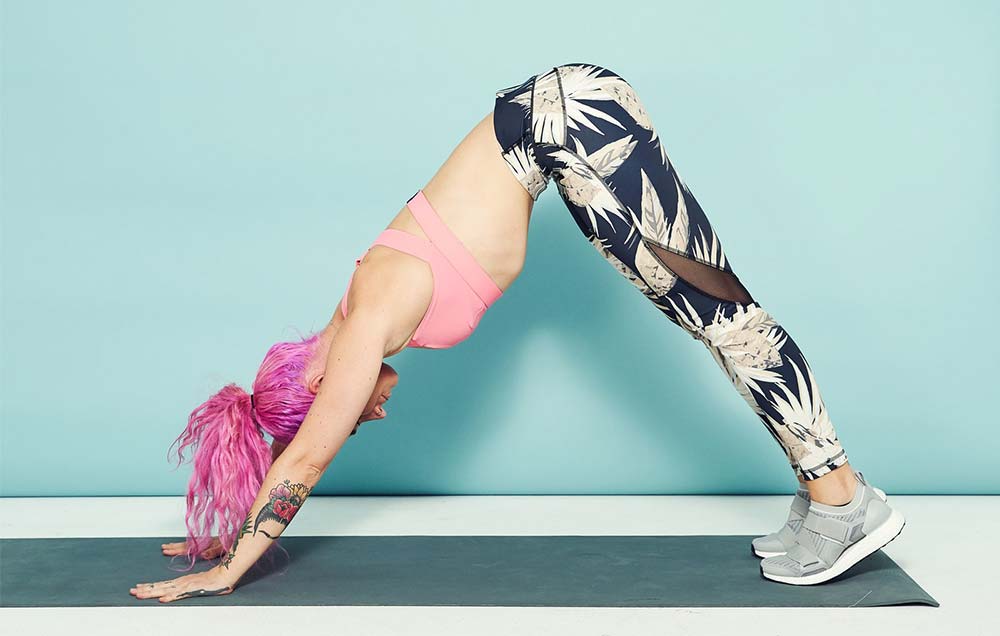
5. Downward Facing Dog
- Start on your hands and knees with your hands stacked under your shoulders and knees under your hips.
- Spread your hands wide and press your index finger and thumb into your mat.
- Lift your tailbone and press your butt up and back, drawing your hips toward the ceiling. Straighten your legs as best as you can and press your heels gently toward the floor.
- Your head should be relaxed between your arms, facing your knees; your shoulders should be pulled back and down; and your back should be flat. You may feel a stretch in your hamstrings, calves, back, and/or shoulders.
- Hold for 30 to 60 seconds.
To help relieve low back tension, bend your knees. Keeping straight knees will work hamstring and glute mobility.
6. Forward Fold
- Stand with your feet shoulder-width apart.
- Straighten your legs out as much as you can without locking your knees and let your torso hang down.
- Tuck your chin in toward your chest, relax your shoulders, and extend the crown of your head toward the floor to create a long spine.
- Depending on your flexibility, your hands will touch the floor or dangle above floor level. You can hold onto each elbow with the opposite arm or let your arms hang separately.
- You should feel a stretch in your back and hamstrings.
- Hold for 30 to 60 seconds.
If you feel tension in your low back, bend your knees. For a deeper release of tension in the back and hamstrings, place a block underneath your hands and press into it.
7. Seated Spinal Twist
- Sit up straight on your butt with your legs crossed. Make sure you’re not rounding your pelvis.
- Place your left arm on your right knee and your right arm behind you, fingers on the ground facing away from your body.
- Inhale and elongate your spine, then exhale and rotate to the right. Your goal is to look over your right shoulder while also keeping both shoulders relaxed and away from your ears.
- Hold for 30 to 60 seconds. Switch sides and repeat.
Take your time to ease into this stretch; don’t yank your spine.
8. Pigeon Pose
- From a kneeling position, get into Downward Facing Dog and extend your right leg high behind you. Then bring your right leg underneath your body and place it in front of you with your shin parallel to the top of your mat. (The goal isn’t to create an L-shape with your right leg; your foot can be tucked as close to your hips as needed.)
- Extend your left leg long behind you and rest the top of your foot on the mat.
- Keep your right foot flexed and try to keep your pelvis neutral and your left hip as close to the mat as you can. If your hip lifts off the floor, bring your right foot a little closer to your body.
- You should feel a stretch in your right hip. Hold for 30 to 60 seconds. Switch sides and repeat.
To make sure your pelvis stays neutral, place a block or pillow underneath your externally rotated hip. You can also place a pillow or block underneath the knee on your straight leg to alleviate any pain. For a deeper stretch, lean your torso forward and rest your forehead on the ground, arms framing your face or resting at your sides.
